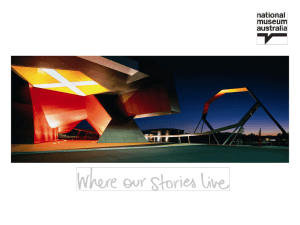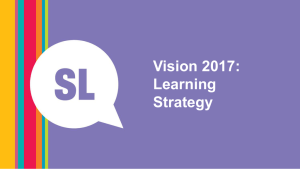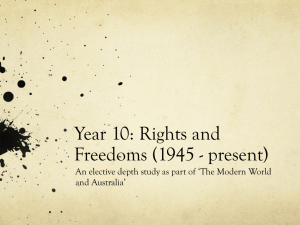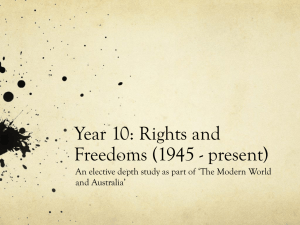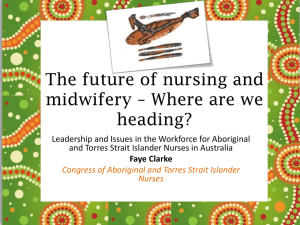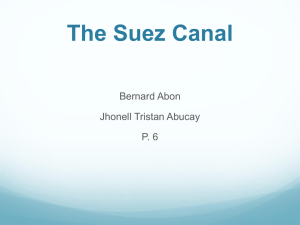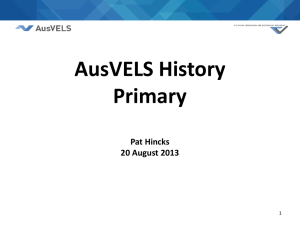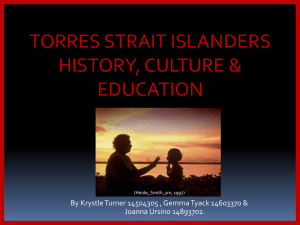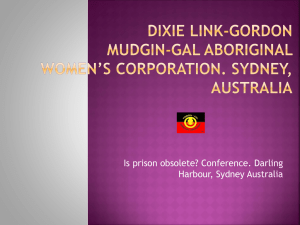WATCH - Queensland Art Gallery
advertisement
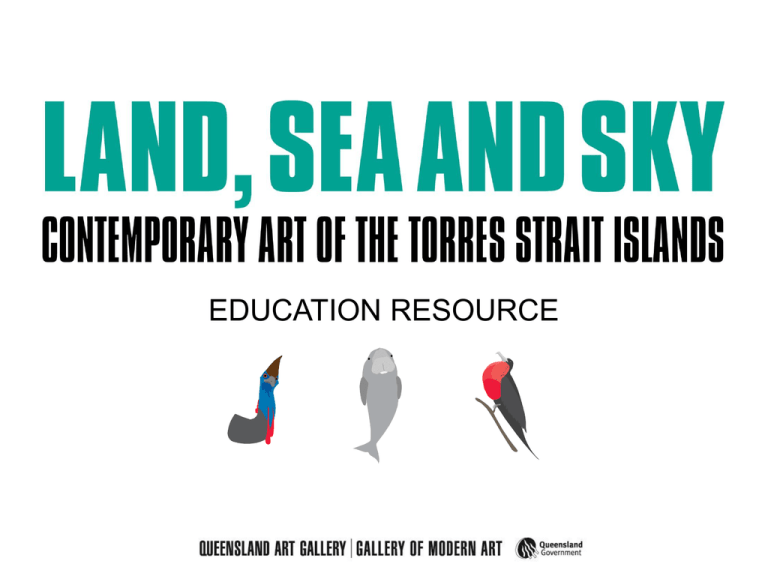
EDUCATION RESOURCE LOCATION The Torres Strait Islands are located between Cape York — the northernmost point of the Australian mainland — and Papua New Guinea. Do you have friends or family from this region of Australia? Find a map of the Torres Strait. How many islands are in the Strait? Choose an island you’d like to visit. What is its traditional name? As you walk through the exhibition, note of the different ways of making art used by the people of the Torres Strait. How many styles can you see? From The Torres Strait Islands, Queensland Art Gallery/Gallery of Modern Art, Brisbane, 2011, p.6. INTRODUCTION People from the Torres Strait Islands have made art, told stories and sung songs about the islands for many years. The land, the sea and the sky are very important to their way of life, and these themes often appear in works by artists from this region. Dennis Nona is an artist who has incorporated all three in this art work. What aspects of land, sea and sky can you identify? Dennis Nona / Kala Lagaw Ya people / Australia QLD b.1973 / Malu lag a dapar – A urungu aidal (Sea, land and air creatures) 2000 / Linocut, hand-coloured on BFK Rives Dennis Nona / Kala Lagaw people lag a dapar A urungu aidal land and air paper, ed.42/75, secondYa state / 87 b.1973 x 50cm // Malu Purchased 2002.-Queensland Art (Sea, Gallery creatures) 2000/ /Collection: Linocut, hand-coloured on Gallery BFK Rives paper, ed. 42/75, second state / 87 x 50cm / Foundation Queensland Art Purchased 2002. Queensland Art Gallery Foundation Collection: Queensland Art Gallery LAND ‘Land, Sea and Sky: Contemporary Art of the Torres Strait Islands’ shows how important these elements of nature are to Torres Strait Islanders and how their art is often influenced by the environment. The position of stars and planets indicates a time to cultivate, plant or harvest. Torres Strait Island elders observe the sky closely, noting connections between the stars, the weather and the tides that signal the change in seasons. This customary knowledge is still used, enabling Islanders to live safely and sustainably. Erub (Darnley Island) Image courtesy: Queensland Art Gallery Image Archive WEAVING IN THE TORRES STRAIT Watch the video to learn more about traditional Torres Strait Island weaving techniques. What are some of the weave variations you can see? List the traditional and synthetic materials used by weavers. Sarah Stephen / Erubam Le people b.1950 / Bos epei (Food mat) 1998 (l) / Woven coconut leaf / 1999.8 / Bos epei (Food basket) 1998 (r) / Woven coconut leaf / 1999.93 / Purchased with funds from the Visual Arts Craft Board of the Australia Council 1998 / City of Townsville Art Collection JENNIFER MYE JR Jennifer Mye Jr weaves attractive, durable baskets using multi-coloured tape. She creates patterns derived from traditional weaves and is also inspired by Pacific Island techniques. What flags are represented in Jennifer Mye Jr’s work? Have you been taught a method or technique by a family member which you could incorporate into an art work? Jennifer Mye Jr was taught to weave by her mother, Jenny Mye. Jenny is also an artist, and is well known for her meticulous weaving and innovative approach to art. Jennifer Mye Jr / Meriam Mir people / Australia QLD b.1984 / Basket with short handles 2011 / Woven polypropylene tape (blue with Australian flag motif) / Purchased 2011 with funds from Thomas Bradley through the Queensland Art Gallery Foundation / Collection: Queensland Art Gallery GEORGE NONA George Nona is known for his skill in making dhoeris and for reviving designs that often haven’t been seen in almost a century. Most importantly, he consults with the elders in his community to test cultural authenticity of the designs. What other cultures create headdresses and dance costumes for ceremonies and rituals? George Nona / Kala Lagaw Ya people / Australia QLD b.1971 / Ceremonial Dhoeri 2008 / Cane, bamboo, string with natural pigment, beeswax, shell, seed, eagle, cassowary and pheasant feathers / Purchased 2009. The Queensland Government’s Gallery of Modern Art Acquisitions Fund / Collection: Queensland Art Gallery George Nona made these headdresses as art works. Examine this photograph of a dance group from Erub wearing their traditional headdresses. Torres Strait Islanders used cassowary feathers to trade with the people of Papua New Guinea. What other items were traded? Find a photograph of a Native American headdress. What’s similar about this and George Nona’s dhoeri? WATCH Listen to George Nona’s video. What is the significance of the materials used to create the dhoeris? What does the number of feathers used indicate? The Saam Karem Ira Kodo Mer Dance Troop from Erub (Darnley Island) performing the ‘Au Seuwiri Ermare’ canoe dance, meaning ‘To go out to Seu Reef and spear the biggest silver mullet there’, at Winds of Zenadth Cultural Festival on Thursday Island, September 2010 / Composer/Music/Choreography: Kapua Gutchen Sr / Photograph: Bruce McLean JAMES ESELI Ubirikubiri is an ancestral spirit figure from the Torres Strait in the form of a crocodile, and its accompanying song and dance come from Mabuiag Island. In the performance, the crocodile and villagers act out their roles: the crocodile is alert and looking for prey while the villagers watch from a safe distance. Here you can see the small sanderling birds, believed to have a connection with crocodiles: they are sometimes seen on the backs of the reptiles. DID YOU KNOW ...? Due to the fears of Japan invading Australia during World War Two, the late James Eseli was one of many Torres Strait Island children taken from his home island to the safety of Waiben (Thursday Island). This relocation had an effect on the artist which can be seen in some of his other works in the exhibition. Does your family have traditions and stories which have been passed down from previous generations? James Eseli / Kala Lagaw Ya people / Australia QLD 1929–2009 / Ubirikubiri (crocodile) headdress 2004 / Cotton tree wood, enamel paint, pencil, feathers, plastic, raffia, copper wire, toothpicks, lead pencil, string, fixative, aluminium, glass marbles / Purchased 2005. Queensland Art Gallery Foundation Grant / Collection: Queensland Art Gallery LAND ACTIVITIES Research the traditional ways Torres Strait Islanders examine the positions of the stars and planets to assist them on the land. See if you can find out when it is a good time to cultivate, plant or harvest. Are these times of year supported by contemporary gardening methods today? Fans, baskets, bags and bowls — what other practical things are created by weaving? Mark where you live on a map of Australia. Calculate how far it is from where you live to Erub (Darnley Island). Find Erub on Google Maps, view it via satellite and describe the landscape. Create a collage using natural elements collected from your school or backyard. Can you arrange these items in an interesting way? What materials will you use? What message about your life do you want to reflect? SEA As well as being a source of food and enjoyment, Torres Strait waters can be dangerous. For Islanders, survival often depends on the ability to read the currents, the wind, and the moods of the sea. Basic sea foods are readily available and inspire songs or dances — the image of a lone fisher with his net flying through the air, or the silvery sheen of fish scales, evoke tranquillity, grace and beauty. The Torres Strait Image courtesy: Queensland Art Gallery Image Archive MAHNAH ANGELA TORENBEEK Mahnah Angela Torenbeek lives in an astonishing old bakery filled with craft and colour. The crumbling original brick oven and objects collected from the beach nearby sit happily alongside her eccentric furniture, such as a table made from stacked truck tyres with a tabletop that happened to float her way. What types of materials do you find in your natural environment which could be used in weaving? Research GhostNets Australia. What environmental issues are relevant to your life? How could you help to remove this problem? DID YOU KNOW ...? Mahnah Angela Torenbeek / Wagalgai people / Australia QLD b.1942 / Ghost net basket (detail) 2011 / Coilwoven polypropylene fibre / Purchased 2011 with funds from Thomas Bradley through the Queensland Art Gallery Foundation / Collection: Queensland Art Gallery One of the largest nets found to date, in the Gulf of Carpentaria, was a Taiwanese gill net over six kilometres long and weighing six tonnes. ROSIE BARKUS Rosie Barkus works from her home studio on Waiben (Thursday Island). Her printed textile prints highlight the protection of Australia’s northern borders by more than 800 Torres Strait men during the war in the Pacific (1942–45) and the lives of the women and children they left behind; the fate of sailors shipwrecked in dangerous Torres Strait waters, beheaded by local warriors; and the history and influence of the pearling, trochus, bêche-de-mer and crayfishing industries that have dominated the Torres Strait economy in the last century. Bêche-de-mer are sea cucumbers. Have you ever seen one? Find out more about this creature. Think about the process used to make these prints. Find the name of a major shipwreck in the Torres Strait. How did it happen? WATCH Rosie Barkus / Muralug people / Australia QLD b.1959 / Shipwrecks 2011 / Commercial cotton fabric, block and screenprinted, fabric paint / Commissioned for ‘Land, Sea and Sky: Contemporary Art of the Torres Strait Islands’ / Purchased 2011 with funds from Thomas Bradley through the Queensland Art Gallery Foundation / Collection: Queensland Art Gallery Listen to Rosie Barkus as she discusses the imagery in her fabric prints. KEVIN O’BRIEN Kevin O’Brien’s Family tree 2011 is based on an image of the buoys that hang from almond trees along the shore of Kirriri (Hammond Island), in front of his auntie and uncle’s place. Underneath the buoys are a fireplace and some benches with a view of the water. This is a good setting for all kinds of conversations. If you were to create a three-dimensional representation of your family tree, how would you do it? What materials would you use? WATCH Take a closer look at Kevin’s ancestry and the meaning of his art work, Family tree 2011. What names and symbols can you see? Kevin O’Brien / Meriam Mir/Kaurareg peoples b.1972 / Family tree (installation views) 2011 / Marine polystyrene floats, stainless steel cable, timber, paint, polyethylene netting / Commissioned for ‘Land, Sea and Sky: Contemporary Art of the Torres Strait Islands’ / Courtesy: The artist The original family tree on Kirriri (Hammond Island) / Photograph: Kevin O’Brien KEN THAIDAY SR Ken Thaiday Sr grew up on Erub (Darnley Island), in the eastern Torres Strait. There, he learned about the habits of Beizam, the hammerhead shark, and was taught the songs and dances related to it. Recognising the supremacy of Beizam in Torres Strait waters, Thaiday has said: I call it Beizam, the symbol of Law and Order, because he is the king of the water and no-one else; you see, this is their territory . . . What adjectives would you use to describe this headdress? Billy Missi / Kala Lagaw Ya people / Australia QLD b.1970 / Kulba yadail (Old lyrics) 2006 / Linocut on paper, ed.16/90 / Purchased 2009 with funds from Xstrata Community Partnership Program Queensland through the Queensland Art Gallery Foundation / Collection: Queensland Art Gallery SEA ACTIVITIES Printmaking. Create your own stencil with a piece of lino (10 x 10cm) and carve a pattern into this based on the Brisbane River. Roll paint over the lino and press it onto fabric to create your print. Use the fabric to make your own simple library book bag. As a class, create choreography about the seas of Moreton Bay, or near where you live. For example, it could be a battle scene, or you may choose to be a type of sea creature. Include props, music, and dance movements. Research your family origins. Design your family tree in light of an important event in your family’s history. For example, were your ancestors farmers, shearers or city dwellers? Did they fight in any of the World Wars? Did they live abroad? SKY The skies of the Torres Strait are closely observed by the elders. They note the multiple connections between the stars, the wind, rain, tides and other signs from nature that usher in the seasons and seasonal activities. Men tell by stars and tide the right time to hunt; they must also foretell the weather before they set out to sea, and observe the movements of birds such as waumer (frigatebird) and gainau (Torres Strait pigeon). Fish traps, Erub Image courtesy: Queensland Art Gallery Image Archive ALICK TIPOTI Alick Tipoti was born on Waiben (Thursday Island). Tipoti seeks his elders’ permission to retell narratives of earlier times, when warrior heroes reigned. His starkly contrasting art works are both eyecatching and mesmerising, and are often inspired by the traditional motifs once inscribed on ritual artefacts. WATCH Listen to Alick Tipoti talk about his ancestors and mural. Alick Tipoti / Kala Lagaw Ya people / Australia QLD b.1975 / Kaygasiw-Usul (Trail of dust underwater created by the shovel nose shark) … Milky way 2011 / Mural / 7.5 x 53.48m / Commissioned for ‘Land, Sea and Sky: Contemporary Art of the Torres Strait Islands’ / Courtesy: The artist A long time ago there were no stars . . . The Kaygas slowly swims in shallow waters along the sandbank at low tide . . . When disturbed, it takes off creating a murky dusty trail . . . In the pitch dark the trail is lit up by Zagu (phosphorescence) . . . Suddenly this activity is reflected up to the Heavens . . . A trail of stars is created . . . This is known to my people as the ‘Kaygasiw-Usul’ . . . Alick Tipoti, 2011 BILLY MISSI Woodcarving is one of the most important art forms in the Torres Strait, as it is in many Pacific cultures. Masters would carve many ceremonial and utilitarian items and decorate them in the rhythmic patterning known as minaral. Today, many young Islander men apply these skills to printmaking. Kulba Yadail (the swaying pattern that runs diagonally from the top left to the bottom right) teaches us to read the stars, the moon and the sea . . . it describes our environment, our culture and also our identity. Billy Missi, 2006 Describe the artist’s depiction of the sky in relation to this quote. Billy Missi / Kala Lagaw Ya people b.1970 / Kulba yadail (Old lyrics) 2006 / Linocut on paper, ed. 16/90 / 84.7 x 47.8cm | Purchased 2009 with funds from Xstrata Community Partnership Program Queensland through the Queensland Art Gallery Foundation / Collection: Queensland Art Gallery SEGAR PASSI In his paintings, Segar Passi documents aspects of the knowledge held by Islanders that allows them to read the weather. Safety at sea is paramount for any island dweller, and Passi learnt from an early age to read signs of rips and whirlpools, tides and currents, and their intimate relationship with the movements of the stars and planets. From cloud formations, Passi can even foretell sad family news. Look outside and describe the sky. Identify the different types of clouds you can see. Predict the weather for tomorrow and then see how accurate your predictions are. What methods do scientists use today to make weather predictions? Segar Passi / Meriam Mir people / Australia QLD b.1942 / Irmerira baz 2011 / Synthetic polymer paint on paper / Commissioned for ‘Land, Sea and Sky: Contemporary Art of the Torres Strait Islands’ / Purchased 2011 with funds from Anne Best through the Queensland Art Gallery Foundation / Collection: Queensland Art Gallery SKY ACTIVITIES Study the sky at the same time each day for five days. In small groups, develop a soundtrack for the weather using a computer program. Play the score back to the class. Select an artist from the exhibition and present a talk about the way he or she addresses traditional stories and practices. Choose one island in the Torres Strait and research the way people live and work there. Create a three-dimensional representation of the sky. You might like to think about the following elements: • colour • cloud patterns • light • time of day — sunrise, morning, noon, sunset • weather — raining, sunny, cloudy, windy CURRICULUM INFORMATION Visual Art Students will: • analyse the structure, content and technical features of Torres Strait Island art works to understand characteristics of personal style • consider the ways Torres Strait Islander artists use imagery from traditional and cultural artefacts Studies of society and the environment Students will: •consider how Torres Strait Islander identities are influenced by different factors, including family, communities, nationality, socioeconomic factors and cultural beliefs Media Students will: • discuss the ways photographs are created and positioned (e.g., ‘real’ versus constructed) • think about how still and moving images, sounds and words are used to construct and reconstruct meaning • examine representations of Torres Strait Islander people, places, events, ideas and emotions, and the ways these are constructed and influenced by different beliefs and ideas English Students will: • evaluate the ways stories and narratives in art relate to historical events or objects (i.e., allegorical and symbolic details) • demonstrate and analyse the relationships between audience, subject matter, purpose and text type • consider how texts can reflect points of view, beliefs and cultural understandings • examine the way non-literary texts entertain, evoke emotion and develop theme SPONSORS
